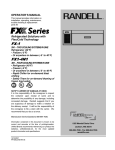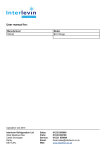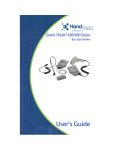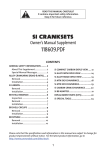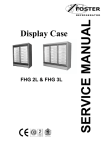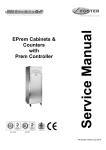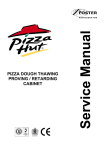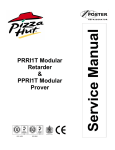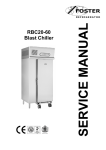Download Fortinet 1000 Network Card User Manual
Transcript
QC 11 & QC 600 Blast Chiller & BQCF 40 Chill / Freeze Bakery Cabinet Contents Introduction Model Details QC 11 & QC 600 BQCF 40 Blast Chill Operating Instructions Controller operating instructions LED’s and there meanings Program function and operation. Cycle Parameter Definitions. Cycle Parameter Access QC 11 Cycle Parameters. QC 600 Cycle Parameters. BQCF 40 Cycle Parameters. Function Menu Parameter Access and modification Parameter Settings Parameter Definitions Printer Management Alarm Signals Controller Electrical Connections Technical Data Wiring Diagram Numbers 1 Page 2 2 3 4 4 5 5 5 5 to 6 6 6 to 7 7 to 8 8 8 to 9 9 to 11 11 11 11 12 12 Introduction. Cook Chill Operation. Blast chilling is a process to reduce the temperature of cooked food by swiftly arresting the cooking process, locking in its colour, flavour, texture and nutritional value. Department of health guidelines state that to safely blast chill food the temperature must be reduced from +70°c to +3°c within 90 minutes. Pre Chill ensures the correct cabinet temperature in the unit before chilling commences therefore improving the chilling performance. Program 1 Soft Chilling. Soft chilling is the process of rapid but gentle chilling of food. This cycle brings down the food temperature to +3°c in no more than 90 minutes without the air or food temperature going below +2°c. This prevents large ice crystals forming therefore maintaining the texture, consistency and appearance of food such as vegetables, rice, pasta, custard and fruit with no dehydration or cell damage. Program 2 Hard Chilling Time. Hard chilling is the process of general purpose chilling using time. This cycle brings down the food temperature to +3°c in no more than 90 minutes and is ideal for chilling meat pies, lasagne, pasta and individually portioned meals. The air temperature for this process goes down to -15°c for the first 70 minutes of the cycle, to extract the maximum amount of heat from the product quickly. The air temperature then increases to +2°c for the final 30 minutes of the time to reduce surface damage and ensure quality. Program 3 Hard Chill + This program is for specialist chilling only and not recommended for normal use. Program 4 Hard Chilling Temperature. Hard chilling is the process of general purpose chilling using the food probe. This cycle brings down the food temperature to +3°c in no more than 90 minutes and is ideal for chilling meat pies, lasagne, pasta and individually portioned meals. The air temperature for this process goes down to -15°c for the first 70% of the cycle, to extract the maximum amount of heat from the product quickly. The air temperature then increases to +2°c for the final 30% of the time to reduce surface damage and ensure quality. Longer Term Storage – ‘Hold’ Mode (Conservation) Upon the completion of the blast chilling cycle the controller will automatically enter the ‘Hold’ mode. This will either be because the selection set time has elapsed or the product core temperature has been achieved. When the hold period commences an alarm will sound for a period denoted in the service operating parameters. The controller will determine the temperature to be maintained during the hold phase based on the chilling or freezing cycle that has been completed. If a soft or hard chill has taken place the controller will maintain an air temperature of 2°c, if a freeze program is completed the air temperature of -21°c will be maintained. The hold mode is principally intended as a temporary storage facility offering the operator flexibility until the product can be unloaded into a longer term storage units at the correct storage temperature. On occasion this hold period may become extended to operate overnight or to provide emergency refrigeration backup. In such instances defrosting would automatically occur as necessary. Model Details. Cabinet Blast Chiller & Freezers. Controls located in the unit cover. All of the cabinet range incorporate a bottom mounted refrigeration systems with the evaporator located on the back wall. The refrigerant used is R404a. Door operated fan switches stop the fans when the door is opened. QC11, QC 600 all 230/1/50Hz 13amp. QC11: Economy Blast Chiller, 11kg capacity with three GN1/1 shelves. QC 600: Economy Blast Chiller, 40kg capacity BQF 40: Bakery Quick Freeze, 2 QC 11, QC 600 & BQCF 40 Blast Chill Operating Instructions. Operation --- When mains electrical power is first applied to the controller it will carry out a self-test function for approximately 3 seconds, after this the cabinet air temperature will be displayed. To start, select the program required by pressing the program mode button (1, 2, 3,4), the LED for that mode will illuminate, press and hold start key for three seconds to start the program. The display will show the program time. The compressor may pause before starting at the start of a cycle to prevent short cycling of the condensing system and is normal. When the time or temperature is achieved the machine will go in to the Hold mode with the sounding of an alarm. To stop the cycle press and hold the start key for 2 seconds, the cycle will be terminated. Manual Defrost. When the blast chiller is in hold press the defrost key and hold for 2 seconds to start the defrost. When defrost is complete the machine will revert to the hold temperature. Program Mode Program Type Program Time Air Temperature Chill Temperature Hold Temperature SOFT 90 90 minutes @ +2°c N/A +3°c HARD 90 70 minutes @ -15°c 20 minutes @ +2°c N/A +3°c HARD + 240 240 minutes @ -15°c N/A +3°c 75% @ -15°c 25% @ +3°c 75% @ -6°c 25% @ +2°c +3°c HARD IMPORTANT. Please note: Program 3 is for specialist markets only and not for normal use. Introduction There are four main programmes that you will need to use your Blast Chiller. Soft Chill- for the safe chilling of delicate products. Hard Chill Time - For general purpose chilling based on time. Hard Chill +-. This program is for specialist chilling only and is not recommended for normal use. Hard Chill Temperature - For general purpose chilling using the food probe. Guide for Blast Chilling Food Type Includes Meat Beef, pork, lamb, poultry & mince Fried, poached or baked – haddock, plaice, salmon, cod fillets etc Stews & casseroles, lasagne, risotto, shepherds pie Steamed or roasted veg, rice and potatoes etc. Stewed and cooked fruits. Cakes Pastries Fruit Based desserts & egg based flans. Sponge puddings and dense desserts such as cheesecake. Fish Prepared dishes Vegetables & Pulses Fruit Bakery Bakery Desserts Desserts 3 Blast Chill Programme required 2 or 4 1 2 or 4 1 1 2 or 4 2 or 4 1 2 or 4 Controller operating instructions DEFROST/ UP 4 3 5 2 START/ STOP 1 DOWN SET Display Set Point: Press the SET key whilst in the HOLD Mode will display the set point for 5 seconds. Modify Set Point: Press and hold the SET key for 2 seconds. The SET point will be displayed and the LED’s of the first and third digits will blink. To change the value, press the UP key to increase the value or the DOWN key to decrease. To store the new value either press the SET key or wait for the controller to return to displaying air temperature. Manual Defrost: Press and hold the DEFROST/UP key for 2 seconds to initiate a manual defrost. Starting the cycle: Press and hold the START/STOP key for 3 seconds. Temporarily Stopping the Cycle: Press and release the START/STOP key. The condensing system will stop and the message “Stb” will be displayed. To restart the cycle press and release the START/STOP key for the cycle to continue from the point it was interrupted. Alternatively the cycle will restart automatically after the time set in parameter PAU (see parameter list on page ). Stopping the Cycle: Press and hold the START/STOP until the display shows “End”, the buzzer will sound and the unit will enter the stand by mode. LED’s and there meanings A series of LED’s, number 1 to 4, on the front panel are used to indicate certain functions controlled by the controller. There functions are listed below. LED 1 1 1 2 2 2 3 3 4 4 5 Mode Illuminated Flashing Flashing Illuminated Flashing Flashing Illuminated Flashing Illuminated Flashing Illuminated Function Compressor Enabled Programming Phase (flashing with LED 2). Anti Short Cycle Enabled Fan/s Enabled Programming Phase (flashing with LED 1). Activation Delay Active Defrost Active Drip Time Active Freezing Cycle or Hold Mode Active Instrument Temporarily Stopped Alarm Signalling 4 5 Illuminated When in program Pr2 indicates the parameter is also present in Program function and operation. Each of the programs is divided into 3 phases of operation. Phase 1: Hard Chill. Phase 2: Soft Chill. Phase 3: Freezing Cycle. For each phase there are 3 parameters. IS1 (iS2, iS3): operation controlled by the Food Probe. RS1 (rS2, rS3): set point for the room Temperature Probe for each phase. Pd1 (Pd2, Pd3): The maximum time duration for each phase. Hds: hold phase set point at the end of the whole cycle. There are also 2 parameters relating to defrost. These are dbC = Defrost Before cycle, dbH = defrost before hold (at the end of the cycle). Cycle Parameter Definitions. Parameter dbc: First Phase iS1 Range yes/ no Minimum ------------ Description Defrost before cycle 50 to + 50°C 1°C or 1°F rS1 50 to + 50°C 1°C or 1°F Pd1 Second Phase iS2 OFF to 4.0 hours 10 minutes Food Probe Set Point (when the temperature measured by the food probe reaches this value the first phase is ended). Air Temperature Set Point (prevents the air temperature going to low during the first phase). Maximum Time For The First Phase 50 to + 50°C 1°C or 1°F rS2 50 to + 50°C 1°C or 1°F Pd2 Third Phase iS3 OFF to 4.0 hours 10 minutes 50 to + 50°C 1°C or 1°F rS2 50 to + 50°C 1°C or 1°F Pd3 OFF to 4.0 hours 10 minutes yes/ no 50 to + 50°C or OFF -----------1°C or 1°F Food Probe Set Point (when the temperature measured by the food probe reaches this value the second phase is ended). Air Temperature Set Point (prevents the air temperature going to low during the first phase). Maximum Time For The Second Phase Food Probe Set Point (when the temperature measured by the food probe reaches this value the whole cycle is ended). Air Temperature Set Point (prevents the air temperature going to low during the third phase). Maximum Time For The Third Phase. Defrost before the hold phase Set Point OF The Hold Phase. If set to OFF the hold Phase is disabled. Important Note: If the duration time phase is set to OFF the corresponding phase is disabled. E.G. If Pd3 = OFF the third phase of the cycle is not active. dbH HdS Cycle Parameter Access To access the cycle parameters Press and Hold the Set and Down buttons for 2 seconds. The display will show “Prb” press the down button and scroll through until you get to “FCY” cycle management. Press Set “Cy1” will be displayed, press the down button to scroll through the submenu to select the required cycle parameters. Once selected press the set key to access the cycle parameters. QC 11 Cycle Parameters. Soft Chill- for the safe chilling of delicate products. (Cy1) dbC = no iS1 = -10°C rS1 = 2°C Pd1 = 1.3 hours iS2 = 5°C rS2 = -2°C Pd2 = OFF iS3 = 3°C rS3 = -2°C Pd3 = OFF 5 dbH = no HdS = 3°C 6 Hard Chill Time - For general purpose chilling based on time. (Cy2) dbC = no iS1 = -15°C rS1 = -15°C Pd1 = 1.1hours iS2 = 2°C rS2 = 2°C Pd2 = 0.2 hours iS3 = -18°C rS3 = -30°C Pd3= OFF dbH = no HdS = 3°C Hard Chill +-. This program is for specialist chilling only and is not recommended for normal use. (Cy3) dbC = no iS1 = -15°C rS1 = -15°C Pd1 = 4 hours iS2 = -18C rS2 = -30°C Pd2 = OFF iS3 = -18°C rS3 = -15°C Pd3 = OFF dbH = no HdS = 3°C Hard Chill Temperature - For general purpose chilling using the food probe. (Cy4) dbC = no iS1 = -6°C rS1 = -15°C Pd1 = 1.1 hours iS2 = 3°C rS2 = 2°C Pd2 = 0.2 iS3 = -18°C RS3 = -30°C Pd3 = OFF dbH = no HdS = 3°C QC 60 Cycle Parameters. Soft Chill- for the safe chilling of delicate products. (Cy1) dbC = no iS1 = -10°C rS1 = 2°C Pd1 = 1.3 hours iS2 = 5°C rS2 = -2°C Pd2 = OFF iS3 = 3°C rS3 = -2°C Pd3 = OFF dbH = no HdS = 3°C Hard Chill Time - For general purpose chilling based on time. (Cy2) dbC = no iS1 = -15°C rS1 = -15°C Pd1 = 1.1hours iS2 = 2°C rS2 = 2°C Pd2 = 0.2 hours iS3 = -18°C rS3 = -30°C Pd3= OFF dbH = no HdS = 3°C Hard Chill +-. This program is for specialist chilling only and is not recommended for normal use. (Cy3) dbC = no iS1 = -15°C rS1 = -15°C Pd1 = 4 hours iS2 = -18C rS2 = -30°C Pd2 = OFF iS3 = -18°C rS3 = -15°C Pd3 = OFF dbH = no HdS = 3°C Hard Chill Temperature - For general purpose chilling using the food probe. (Cy4) dbC = no iS1 = -6°C rS1 = -15°C Pd1 = 1.1 hours iS2 = 3°C rS2 = 2°C Pd2 = 0.2 iS3 = -18°C RS3 = -30°C Pd3 = OFF dbH = no HdS = 3°C BQCF 40 Cycle Parameters. Soft Chill- for the safe chilling of delicate products. (Cy1) dbC = no iS1 = -10°C rS1 = 2°C Pd1 = 1.3 hours iS2 = 5°C rS2 = -2°C Pd2 = OFF iS3 = 3°C rS3 = -2°C Pd3 = OFF dbH = no HdS = 3°C Hard Chill Time - For general purpose chilling based on time. (Cy2) dbC = no iS1 = -15°C rS1 = -15°C Pd1 = 1.1hours iS2 = 2°C rS2 = 2°C Pd2 = 0.2 hours iS3 = -18°C rS3 = -30°C Pd3= OFF 7 dbH = no HdS = 3°C Hard Chill +-. This program is for specialist chilling only and is not recommended for normal use. (Cy3) dbC = no iS1 = -6°C rS1 = -15°C Pd1 = 1.1 hours iS2 = 3°C rS2 = 2°C Pd2 = 0.2 iS3 = -18°C rS3 = -30°C Pd3 = OFF dbH = no HdS = 3°C Hard Chill Temperature - For general purpose chilling using the food probe. (Cy4) dbC = no iS1 = -6°C rS1 = -15°C Pd1 = 1.1 hours iS2 = 3°C rS2 = 2°C Pd2 = 0.2 iS3 = -18°C RS3 = -30°C Pd3 = OFF dbH = no HdS = 3°C Function Menu To access the cycle parameters Press and Hold the Set and Down buttons for 2 seconds. The display will show “Prb”. Prb: Probe Display. Allows the probe temperatures to be displayed for ten seconds. • rPr: Displays temperature measured by the AIR probe. • Epr: Displays temperature measured by the EVAPORATOR probe. • IPr: Displays temperature measured by the FOOD probe. Press SET to display the reading of the selected probe, press SET with the reading displayed returns to the probe labels. Probe Fault Identification. rPF = AIR probe fault. EPF = EVAPORATOR probe fault. iPF = Food probe fault. Pr1: User Parameters. Includes all user accessible parameters. If no parameters are present in the menu “Pr2” will be displayed. Pr2: Installer Parameters. Includes all the instrument parameters (at installer level). It can only be accessed using the security code. On entering the parameters it is possible to modify all parameters and add or remove parameters from “Pr1” (user level) by pressing “SET” + “UP”. When a parameter is enabled at user level, LED 5 (Alarm LED) is on. Fcy: Cycle Managent. The Fcy menu contains the Cy1, Cy2, Cy3 and Cy4 sub menus. Each of the sub menus should be set to the Standard Cycle Parameters as detailed on pages 6 and 7. Sto: Cycle Length. The “Sto” menu records the real length of a cycle and the real length of each single phase. It contains the following sub menu: tCy: Cycle Duration. tP1: First Phase Duration. tP2: Second Phase Duration. tP3: Third Phase Duration. rtC: Clock Managent. Real time clock parameters. SEC: Seconds (00 to 59). Min: Minutes (00 to 59). Hou: Hours (1 to 24). 7dY: Day of the week (Mon = Monday. tue = Tuesday. Wed = Wednesday. Thu = Thursday. Fri = Friday. Sat = Saturday. Sun: Sunday) dAY: Day of the Month (1 to 31). Mon: Number of the month (1 to 12). YEA: Year (0 to 99). Alr: Alarms Display. This function displays any alarm messages. Prt: Printer Management. Contains the parameters for the management of the printer. 8 PrP: Printer presence. (Yes or no) Enables or disables the printer. ItP: Printing interval. (0.0 to 30.0). Sets the print interval. PbP: Print probe selection. (iP: only the food probe selected. rP: only the air probe selected. irP: Food and Air probe selected. irE: All probes selected). PtH: (yes or no) Enables or disables the printing during the holding phase. tSt: Starts the controller self test function. Out: Exit from the menu. Parameter Access and modification To access the parameters firstly enter the function menu by pressing the “SET” and “DOWN” keys for 3 seconds. Scroll through the labels and select “PR2”, press the “SET” key. “PAS” label flashes for a few second followed by “0 _ _” with the zero flashing. The access code is ‘ 321’. Use the “UP” or “DOWN” key to input the first number of the security code in the flashing section, confirm by pressing “SET”. Repeat the operation for the second and third digits. If the security code is correct “Hy” will be displayed. NOTE: if no key is pressed for 15 seconds the controller reverts to displaying the room temperature. Parameter Settings Lab Description Default QC 11 QC 600 BQCF 40 3 2 0 0 YES 0 YES 0 °C IN 1 2 3 60 15 10 dor OP 5 AL OP 60 0 2 rP 3 2 0 0 NO 0 YES 0 °C IN 1 2 3 60 15 10 dor OP 5 AL CL 60 0 2 rP 3 2 0 0 YES 0 YES 0 °C IN 1 2 3 60 15 10 dor OP 5 AL CL 60 0 2 rP 3 2 0 0 YES 0 YES 0 °C IN 1 2 3 60 15 10 Dor OP 5 AL CL 60 0 2 rP in YES 6.0 20 20 rt 1 in YES 6.0 20 20 rt 1 in YES 6.0 20 20 rt 1 In YES 6.0 20 20 Rt 1 c_n 30 2 2 O_Y 30 2 2 O_Y 30 2 2 O_Y 30 2 2 Regulation Hy AC 1c2 rPO EPP EPO iPP iPO CF rES PAU PFt iPd iPt Con COF diC diP did OAC OAP OAt OAS OAH OAi differential tdF dPO IdF dtE MdF dFd Fdt Defrost type FnC FSt AFH Fnd Fan operating mode Anti-short cycle delay Second compressor configuration Thermostat probe calibration Evaporator probe presence Evaporator probe calibration Insert probe presence Insert probe calibration Temperature measurement unit Resolution (for °C): Time of stand by Maximum acceptable duration of power failure Temperature difference for the automatic recognition of the insert probe Time delay for the automatic recognition of the insert probe Compressor ON time with faulty probe Compressor OFF time with faulty probe Digital input operating mode Digital input polarity Digital input delay Auxiliary output configuration Auxiliary output polarity AUX output timer Set point for AUX output Differential for AUX output Probe selection for the AUX output Defrost Defrost before holding cycle Interval between defrost cycles Defrost termination temperature Maximum length for defrost Temperature displayed during defrost Drip time Fans Fan stop temperature Differential for the stop temperature and for the alarm Fan delay after defrost 9 Alarm ALU ALL ALd EdA tbA MAXIMUM temperature alarm Ad1 Ad2 Lod rEd LOC PAS tPb rEL Ptb Address 1 for RS485: Minimum temperature alarm Temperature alarm delay Alarm delay after defrost Silencing alarm relay 30 30 60 30 YES 30 30 60 30 YES 30 30 60 30 YES 30 30 60 30 YES 0 1 nr iP no 321 ntc 1,0 -- 0 1 nr iP no 321 ntc 1.0 -- 0 1 nr iP no 321 ntc 1.0 -- 0 1 nr IP No 321 Ntc 1.0 -- Others Address 2 for RS485 Local display Remote display Keypad LOCK Security code set up Type of probe Release code (readable only) Parameter code (readable only) Parameter Definitions REGULATION Hy Intervention differential for set point: (0,1 ÷ 12,0 /0,1°C/1°F), always positive. Compressor cut IN is Set Point Plus Differential (Hy). Compressor cut OUT is when the temperature reaches the set point. AC Anti-short cycle delay: (0÷30 min) minimum interval between the compressor stop and the following restart. 1c2 Second compressor setting: (enabled only if OAC=C2) The fourth relay work as second compressor if OAC=Co2. Second compressor operates on set + OAS. (whit set= set loaded during the current phase). It starts oAt min. after the first compressor The following table shows how it works: Cycle Holding C1 ON; C2 On C1 on; C2 On 1c2=0 C1 on; C2 On C1 on C2 off 1c2=1 C1 on; C2 off C1 on; C2 On 1c2=2 C1 on; C2 off C1 off; C2 On 1c2=3 rPO Thermostat probe calibration (-12,0 ÷ 12,0; res. 0,1 °C /1°F) EPP Evaporator probe presence (not present in the XB350C): (no / YES) no: not present (timed defrost); YES: present (end defrost ) EPO Evaporator probe calibration (not present in the XB350C): (-12,0 ÷ 12,0; res. 0,1 °C /1°F) iPP Insert probe presence (no / YES) no: not present; YES: present. iPO Insert probe calibration (-12,0 ÷ 12,0; res. 0,1 °C /1°F) CFTemperature measurement unit: °C =Celsius; °F =Fahrenheit rES Resolution (for °C): in: integer; de: with decimal point PAU Time of stand by: (0 ÷ 60min) after this time the controller restart the cycle PFt Maximum acceptable duration of power failure: (0 ÷ 250 min) if power failure duration is less than PFt, the cycle restarts from the same point at which it was stopped otherwise the cycle restarts from the beginning of the current phase. iPd Temperature difference for the automatic recognition of the insert probe: (0 ÷ 30; ris.1 °C/1°F) if the difference of temperature between the insert probe and the thermostat probe is less than iPd, the selected cycle is made by time. iPt Time delay for the automatic recognition of the insert probe: (0÷255sec, with 0 only timed cycles are done) time between the start of a cycle and the comparison of the temperature of the thermostat probe and the insert probe to recognising if the insert probe is used. Con Compressor ON time with faulty probe: (0÷ 255 min) time during which the compressor is active in case of faulty thermostat probe. With COn=0 compressor is always OFF COF Compressor OFF time with faulty probe: (0÷255 min) time during which the compressor is off in case of faulty thermostat probe. With COF=0 compressor is always active diC Digital input operating mode (EAL, bAL, dor) EAL: external alarm; bAL: serious alarm; dor: door open function diP: digital input polarity: (OP÷CL)select if the digital input is activated by opening or closing the contact. OP= opening; CL=closing did: digital input delay (0÷255 min) delay between digital input activation and his signalling for configurable or door opened alarm. NOTE: with diC=EAL did has to be different from zero. 10 OAC: AUX output configuration: (AL, Li, UL, Ip, AA, rE, dF, C2) AL: alarm output; Li: light of the cabinet; UL: for the ultra-violet light (It is actionable only when the controller is in OFF position); Ip: to extract the insert probe (It is actionable only when the controller is in OFF position); AA: anti - condensation; rE: the IV relay works as a thermostat, with direct action (cooling) (OAH>0), and inverse actions (heating) (OAH<0); dF: the IV relay is activated during the defrost, at the end of the defrost it remains ON for the OAt time; C2: second compressor. See 1c2 parameter for different settings. OAP AUX output polarity (OP ÷ CL) OP= normally open; if it is ON the terminals 6-8 are closed. CL= normally closed; if it is ON the terminals 6-7 are closed. OAt AUX output timer: (0÷255 min) time in which the AUX output stays ON. It is enabled when OAC = Li or UL or Ip or AA or dF. OAS Set point for AUX output (-50÷50; ris.1 °C/ 1°F) OAH Differential for AUX output: (-12.0÷12,0; ris.0,1°C/1°F, always ≠0) Intervention differential for the set point of the auxiliary, with OAH<0 the action is for heating, with OAH>0 it is for cooling. COOLING: AUX cut IN is OAS Plus Differential (OAH>0). AUX cut OUT is when the temperature reaches the set point OAS. HEATING: AUX cut IN is OAS Plus Differential (OAH<0). AUX cut OUT is when the temperature reaches the set point OAS. OAi Probe selection for the AUX output (rP, EP, iP) rP = thermostat probe, EP = evaporator probe; iP = insert probe DEFROST tdF Defrost type (not present in the XB350C): (rE= electrical heater; in = hot gas). dPO Defrost before the holding: no= no defrost; YES= defrost at the start of a holding cycle. IdF Interval between defrost cycles: (0.1÷ 24.0; res. 10 min) Determines the time interval between the beginning of two defrost cycles. (with 0.0 the defrost is disabled) dtE Defrost termination temperature (not present in the XB350C): (-50÷50 °C/°F) Sets the temperature measured by the evaporator probe, which terminates the defrost. MdF Maximum length for defrost: (0÷255 min) When EPP = no (timed defrost) it sets the defrost duration, when EPP = YES (defrost termination based on temperature) it sets the maximum length for defrost. dFd Temperature displayed during defrost: (rt , it, SEt, dEF) rt: real temperature; it: temperature at the start of defrost; SEt: set point; dEF: “dEF” message Fdt Drip time (not present in the XB350C): (0 ÷ 60 min) Time interval between reaching defrost termination temperature and the restoring of the controllers' normal operation. This time allows the evaporator to eliminate water drops that might have formed during defrost. FANS FnC Fans operating mode during the holding phase: C-n= runs with the compressor, OFF during defrost; o-n = continuous mode, OFF during defrost; C-Y = runs with the compressor, ON during defrost; o-Y = continuous mode, ON during defrost; FSt Fan stop temperature: (-50÷50°C/°F; res. 1°C/1°F) if the temperature, detected by the evaporator probe is above FSt fans are stopped. It serves to avoid blowing warm air around the room. AFH Differential for the stop temperature and for the alarm (0.1 ÷ 25.0 °C; ris.0.1°C/1°F) Fans carry on working when the temperature reaches the FSt-AFH value, the temperature alarm recovers when the temperature is AFH degrees below the alarm set. Fnd Fan delay after defrost: (0 ÷ 255 min) The time interval between end of defrost and evaporator fans start. ALARM ALU MAXIMUM temperature alarm: (1 ÷ 50 °C/°F) When the “SET+ALU” temperature is reached the alarm is enabled, (possibly after the “Ald” delay time). ALL Minimum temperature alarm: (1÷50°C/1°F) When the “SET-ALL” temperature is reached the alarm is enabled, (possibly after the “Ald” delay time). ALd Temperature alarm delay: (0÷255 min) time interval between the detection of an alarm condition and alarm signalling. EdA Temperature alarm delay at the end of defrost: (0 ÷ 255 min) Time interval between the detection of the temperature alarm condition at the end of defrost and alarm signalling. tbA Silencing alarm relay: (Yes= silencing buzzer and alarm relay, no= only buzzer silencing). OTHER Ad1 Address 1 for RS485: (0 ÷ 94) Ad2 Address 2 for RS485 (0 ÷ 94) Lod: Local display: (rP, EP, iP, nr) Select which probe is displayed by the instrument. rP: Thermostat probe. EP: Evaporator probe. iP: Insert probe, nr: During a temperature cycle the insert probe is displayed, during the holding phase the room probe is displayed. If the cycle is made by time the time remaining is displayed (in minutes). rEd Remote display: (rP, EP, Ip) select which probe is displayed by the XR REP. rP: thermostat probe; EP: evaporator probe; iP: insert probe. Loc Set point of the holding phase lock (no - YES) It locks the set point of the holding phase. 11 PAS Security code set up: (0 ÷ 999) tPb Type of probe: it displays the probe used (NTC or PTC) (readable only) rEL Release code (readable only) Ptb Parameter code (readable only) Printer Management The instrument XB570L can drive the serial printer XB05PR by means of the RS232 output. So temperatures measured during a freezing cycle can be printed. The internal Real Time clock of the instrument provides time reference. The “Prt” functions manages the printer by means of the following parameters: Prt: printer presence: (Yes/no) it enables or disables the printer. itP: printing interval: (0.0÷30.0 min). PbP: which probe has to be printed: (iP: Only the insert probe; rP: Only the thermostat probe; irP: Insert and thermostat probes; irE: All the probes. PtH: Printing during the holding phase (yES, no) yES = Printing enabled during the holding phase; no = Printing disabled during the holding phase. NOTE: Although the controller is capable of several features ie. HACCP recording and output, it is intentional by Foster that these have not been developed to maintain the simplicity of operation for the end user. Therefore these features are not offered or supported. Alarm Signals Mess. Cause “EE” Data or memory failure Outputs Alarm output ON; Other outputs unchanged Alarm output ON; Compressor output according to parameters “rPF” Thermostat Probe failure “COn” and “COF” Alarm output ON; Defrost termination is timed; No temperature “EPF” Evaporator Probe failure control on fans. Alarm output ON; Other outputs unchanged; The cycle is made by “iPF” Insert probe failure time Alarm output ON; Other outputs unchanged; “rtC” Real Time Clock data lost Alarm output ON; Other outputs unchanged; The date and the “rtF” Real Time Clock failure duration of the cycle are not available. Alarm output ON; Other outputs unchanged. “HA” Maximum temperature alarm Alarm output ON; Other outputs unchanged. “LA” Minimum temperature alarm Alarm output ON; The freezing cycle restart from the same point at “FF” Fast freezing interrupted by short power failure which was interrupted. “PFA” Fast freezing interrupted by long power failure Alarm output ON; The freezing cycle restart from the current phase. Alarm output ON; Other outputs unchanged. In any case the cycle “OCF” Max duration of the cycle is expired ends when the final temperature is reached Alarm output ON; Other outputs unchanged. “EA” External alarm Alarm output ON; Other outputs OFF. “CA” Serious external alarm Alarm output ON; Other outputs unchanged. “dA” Door open alarm Controller Electrical Connections 12 Technical Data Nominal Chilling Capacity Duty @ -15°C Fans Defrost Load Evaporating Temperature Refrigerant Control Refrigerant Refrigerant Quantity Electrical Supply Total Heat Rejection QC11 11Kg 830w 1 N/A -15°C TEV R404a 1000g 230/1/50 – 13amp 1500w QC600 40Kg 1031w 2 N/A -15°C TEV R404a TBA 230/1/50 – 13amp 2080w BQF 40 Wiring Diagram Numbers Model QC 11 QC 600 BQCsF 40 Wiring Diagram Number 01-233728 01-233729 13 Fuse Rating 13 Amp 13 Amp 13 Amp QC 11 Wiring Diagram QC 600 Wiring Diagram 2 BQCF 40 Wiring Diagram. Sheet 1 of 2 3 BQCF 40 Wiring Diagram. Sheet2 of 2 4 Foster European Operations France Foster Refrigerator France SA Tel: (33) 01 34 30 22 22. Fax: (33) 01 30 37 68 74. Email: [email protected] Germany Foster Refrigerator Gmbh, Tel: (49) 2333 839375. Fax (49) 2333 839377. Email: [email protected] Foster Refrigerator Oldmedow Road Kings Lynn Norfolk PE30 4JU Tel: 01553 691122 Fax: 01553 691447 Website: www.fosterrefrigerator.co.uk Email: [email protected] a Division of ‘ITW (UK) Ltd’ BC11 BC600/SM/08/04



















